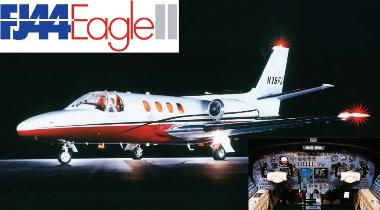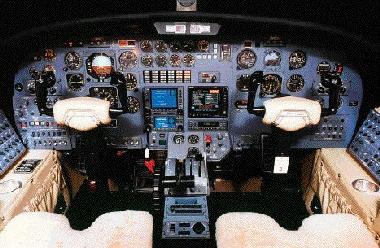Cessna Citation 501 SP
Sierra FJ44 Eagle II
 |
|
 |
Cessna Citation 501 SP
Sierra FJ44 Eagle II
 |
|
 |
There's a light jet on the market for less than $3 million that can climb directly to FL 410, cruise at 375 knots or better while burning 750 pounds of fuel per hour, and fly three to six people 1,600 miles. In the mid-30s, its top speed is more than 400 KTAS. The aircraft is the Sierra Industries modified Citation I, dubbed Eagle II.
And now Garrett Aviation (Booth 4943) and Sierra (Booth 633) have agreed to jointly perform the Eagle II mods at Garrett's facilities. Garrett will fit the aircraft with Sierra's Eagle wing modification, which recontours the inboard wing section and adds 800-plus pounds of fuel capacity.
Garrett also fits the aircraft with Williams FJ44-2 turbofans, replete with FADECs and rated at 2,400-pounds-thrust for takeoff. They produce considerably more thrust in high-altitude cruise than the original aircraft's PWC JT15D-1 turbofans, providing the key to the aircraft's increased speed and range performance.
Garrett is also working to develop an RVSM solution for the Eagle II modified Citations, according to Sierra sales manager Tom Canavera. Once Garrett gains experience with the Eagle II modification, its chain of service centers should be capable of completing 10 to 12 aircraft per year.
Three million dollars is a lot to pay for a mid-80s light jet, even with the performance improvements provided by the Eagle II modification, say critics. But program advocates, including Col. Frank Borman, who was one of the first to take delivery of an Eagle II, couldn't be more pleased.
"Range, speed, the ability to climb directly to FL 430 [when lightly loaded], fuel economy and set-and-forget FADECs," are the aircraft's five best features, Borman told Show News. And the Eagle II is much quieter, Borman said. While the FJ44-2 engines fit into the same nacelles as the OEM JT15D-1 fans, Sierra modifies the aircraft with engine mounts and a supplemental support structure in the aft fuselage that provide much improved noise and vibration isolation.
Borman's aircraft weighs 7,400 pounds empty, loaded with dual Garmin GNS530 navigation systems, a Honeywell KMD850 MFD displaying weather radar, terrain alerts from the Honeywell Enhanced GPWS, and traffic alerts from the Honeywell TAS system. The aircraft also features Sierra's aft baggage compartment modification.